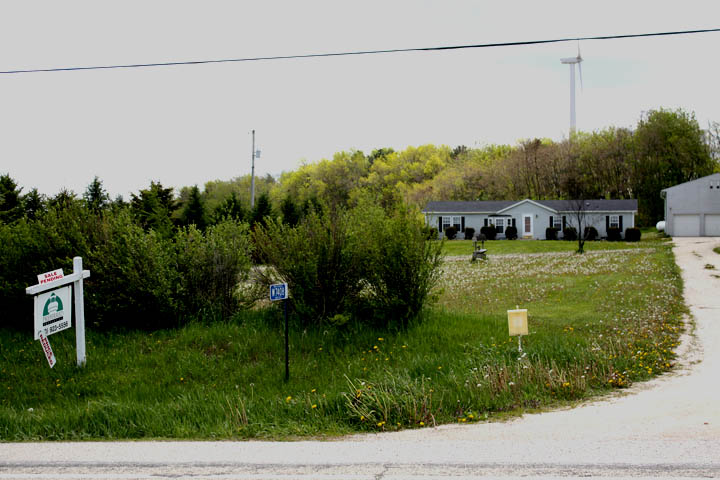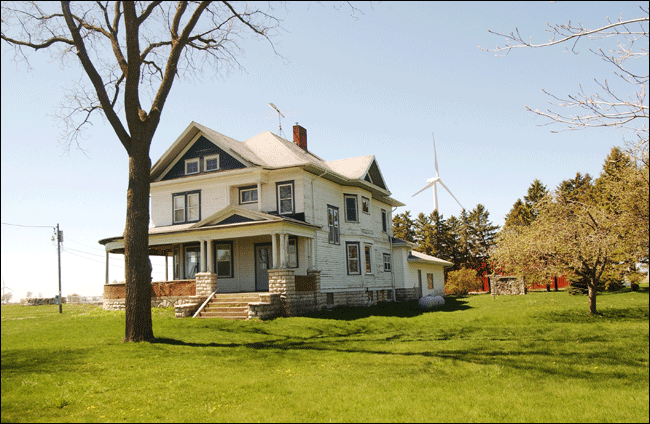Entries in Wisconsin wind siting council (20)
10/14/10 On being a red square in a yellow circle: A wind siting council member weighs in on the real cost of Wisconsin wind farms AND Wind Turbines Too Loud? Sorry Charlie, ain't a lot we can do for you now.
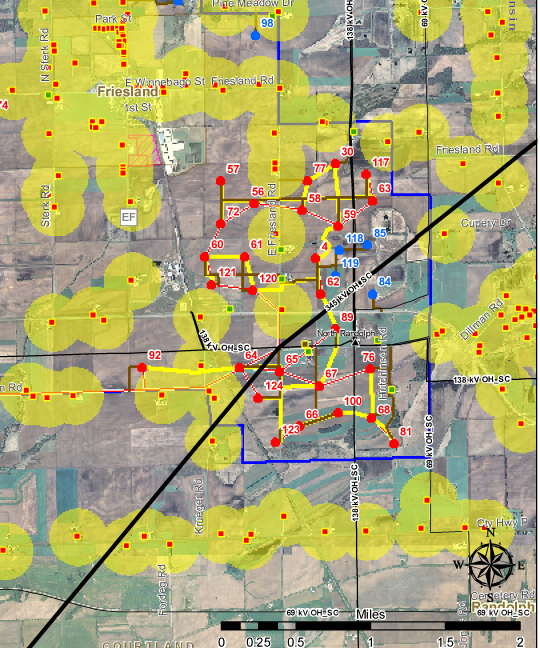
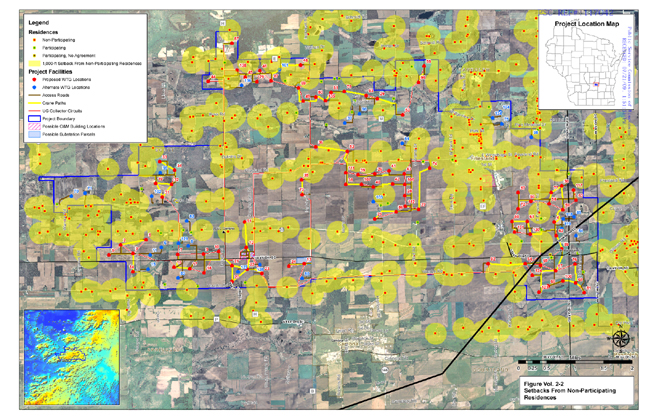
HOW MANY RESIDENTS WILL BE AFFECTED BY THE NEW WIND SITING RULES?
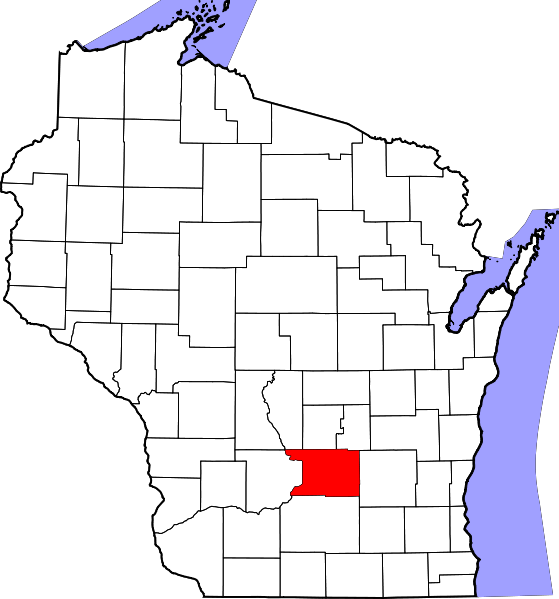
The red squares in the yellow circles on the map above represent non-participating homes in the WeEnergies Glacier Hills wind project currently under construction in Columbia County.
The larger red dots are the turbine locations. [Scroll down to see more detailed maps.]
The new wind rules adopted by the Public Service Commission have the same setbacks from homes as were used for this project.
One difference is the PSC required WeEnergies to offer to buy two homes in the project because seven turbines were to be located within half a mile.
The new rules do not include this sort of protection. Chairman Eric Callisto said by law homeowners have the right to sue the wind developer/owner and he felt that was all the protection they needed.
Although Wisconsin wind farm residents who have been forced to try to sell their homes because of turbine noise and shadow flicker have found no buyers, local wind developers say 400 to 500 foot tall wind turbines located less than 1500 feet a home have no impact on property values.
[CLICK HERE to watch Wisconsin Eye video: During the panel discussion, WPPI vice president Dan Ebert and WeEnergy's head of wind development Andy Hesselbach explain why turbines do not affect property value. ]
Or CLICK HERE to link directly to the Wisconsin Eye 'Newsmakers' feature "Future of Wind Energy"
Developers also say Wind energy is the cheapest way to get renewable energy and cite surveys which indicate stong public support for wind power.
Wind siting council member and Wisconsin realtor Tom Meyer weighs in on the matter.
This is not a question of whether or not people like, or favor "wind" as the lobbyists try to argue. Everyone likes wind, sun, water, earth.
The issue is this: The total cost of generating energy by the use of 400 and 500 foot tall turbines in Wisconsin’s rural communities.
Developers admit that they cannot get investors, who are primarily foreign investors, to put their money up unless the costs of access to the land are depressed.
To get the biggest area to install the highest number of 400 to 500 foot tall turbines, the developer needs to have the greatest access to the most land and compensate the fewest people with the least dollars.
The developer does not need your land, he needs to get one foot [away] from your land.
Every foot the developer is made to move away from a landowner whom he does not have to compensate, adds cost to the developer and reduces the bottom line to investors.
Every dollar spent to gain access to the right to disturbing the peace of a landowner reduces the bottom line.
For wind turbines to be profitable, the industry could improve the technology or depress the cost of access to the land.
By their actions, they prove they believe depressing land costs is more favorable than investing in improving the technology.
Their answer to improved technology is taller and more intrusive. That's not a real solution.
If the turbine can't produce energy without imposing on neighbors, there is no reason to spoil the earth, and threaten the water, and block the sun, to catch the wind.
-Tom Meyer
Wisconsin Wind Siting Council Member
NOTE: Tom Meyer was one of the authors of the minority report from the wind siting council. The report details why some council members strongly disagree with the recommendations sent forth to the Public Service Commission.
CLICK HERE to download pictures of homes in Wisconsin wind projects.
Below, detail maps of non-participating residences in WeEnergies Glacier Hills Project
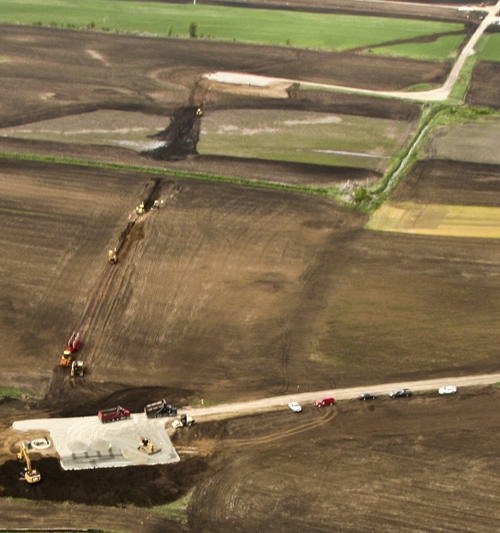
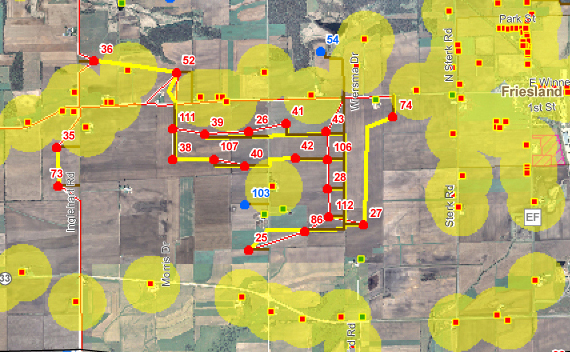
NOTE FROM THE BPWI RESEARCH NERD:
The project mentioned below was sited with the same setbacks and noise limits used to site the We Energies Glacier Hills project. (Detail maps above)
NO EASY SOLUTION TO WIND TURBINE PROBLEM
The Associated Press
VINALHAVEN, Maine (AP) -- The CEO of the electric cooperative that installed wind turbines on Maine's Vinalhaven island says there's disagreement over data suggesting they're too noisy. Fox Island Wind CEO George Baker says his experts dispute the findings of a Department of Environmental Protection consultant who says the turbines violate nighttime noise limits. State law sets a 45-decibel limit. Baker says his experts believe it was ambient noise from wind rustling through trees that exceeded 45 decibels, not the turbines themselves. Baker says it'll be a difficult issue to resolve. He told The Associated Press on Tuesday that slowing the turbine blades to lower the noise level by a couple of decibels may not make appease critics. And lowering it further could hurt the economic viability of the project.
9/2/10 Show me the safety net: PSC commissioner Lauren Azar's letter to legislators AND Show me the green jobs: Wisconsin wind employment figures wither under scrutiny AND What to expect when you're expecting 497 foot tall turbines: Construction begins on Wind Siting Council Member Bill Rakocy's new wind farm AND a letter from Maine that could be from Wisconsin
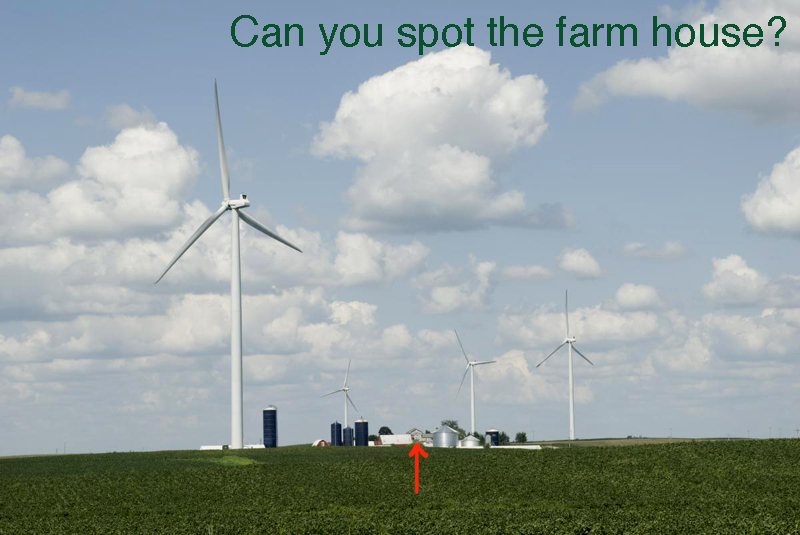
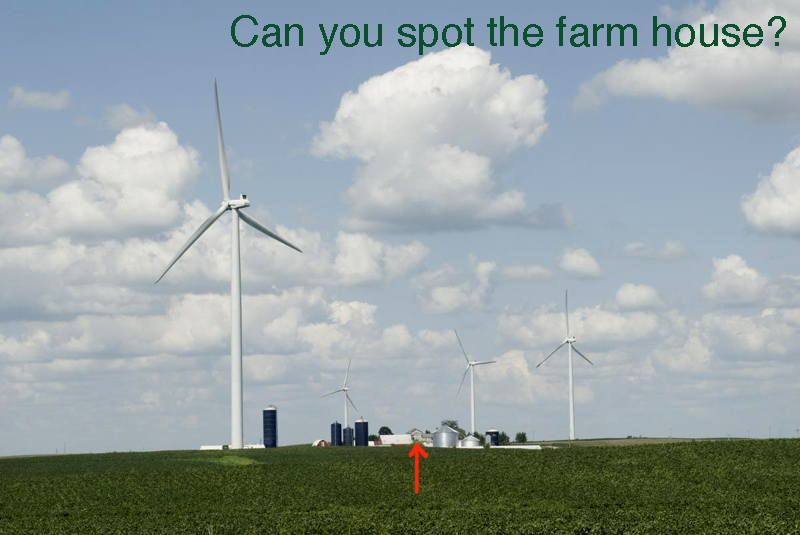
Wind turbines on a Wisconsin Farm
While I support the overall rule because it will promote the development of wind in Wisconsin, the rule fails to provide a much-needed safety net for people whose health declines because of a Wind Turbine located near their home.
-PSC Commissioner Lauren Azar
CLICK HERE TO DOWNLOAD THE FINAL WIND RULES FROM THE PUBLIC SERVICE COMMISSION
SOURCE: PSC DOCKET # 1-AC-231
From PSC commissioner Lauren Azar
To The Honorable Fred Risser The Honorable Michael Sheridan
The State Senate The State Assembly
State Capitol, Room 220 South State Capitol, Room 211 West
Madison, WI 53702 Madison, WI 53702
Re:Wind Siting Rules, Clearinghouse Rule 10-057
Dear Senate President Risser and Speaker Sheridan:
I write to explain my concurrence with the Commission’s rule on the siting of certain wind energy systems (Wind Turbines) in Wisconsin.
While I support the overall rule because it will promote the development of wind in Wisconsin, the rule fails to provide a much-needed safety net for people whose health declines because of a Wind Turbine located near their home.
The safety net I propose would be a minimal burden to wind developers while simultaneously protecting Wisconsin citizens who are sensitive to the noise emitted from Wind Turbines.
Among other things, 2009 Wisconsin Act 40 requires the Commission to develop rules that “provide reasonable protection from any health affects” associated with Wind Turbines. Wis. Stat. § 196.378(4g)(b).
There is substantial evidence that noise from Wind Turbines could negatively impact the health of a small percentage of the population.
To better ensure compliance with Act 40’s mandate, I proposed the following safety net: under limited circumstances, the owner of a Wind Turbine must purchase, at fair market value, the home of someone who can prove that a nearby Wind Turbine is directly causing a significant adverse health outcome. [1]
Unfortunately, at this time, we cannot accurately identify the precise line between safe levels of noise from Wind Turbines and those levels that will negatively affect human health.
Nor do we know why a small percentage of the population is affected more negatively by Wind Turbines than the rest of the population.
As new information becomes available, the Commission can revise this rule.
While more study is needed to better understand the full health impacts of Wind Turbines, it is important that we establish some remedy for the people who can prove that their health is being compromised by nearby Wind Turbines before the Commission has an opportunity to revise this rule.
To be clear, this safety net does not include awarding damages to the injured party; instead, it allows the injured party to move quickly from the area, thereby abating health concerns.
The safety net would be limited to landowners who provide evidence (in the form of a certification) from a licensed Wisconsin medical doctor that one or more Wind Turbines have directly caused a significant adverse health outcome on the injured party.
The only impact to the owner of the Wind Turbine(s) would be the need to resell the house.
Hence, the proposed safety net would not be an onerous requirement on the Wind Turbine owner and should not hamper wind development in Wisconsin.
The safety net could be structured as follows:
“PSC 128.XX Individual Hardships. If the owner of a nonparticipating residence experiences adverse health outcomes that are shown to be the direct result of the operation of a wind energy system, the owner of the nonparticipating residence may petition the political subdivision for mitigation of the adverse health outcomes.
The petition for mitigation shall be referred to the Commission, which may order mitigation of the adverse health outcomes.
A medical doctor licensed in the State of Wisconsin shall attest that that one or more wind turbine(s) have caused a significant adverse health outcome on the injured party before any relief may be granted under this section.
Mitigation may include requiring the owner of the wind energy system to purchase the nonparticipating residence at fair market value.
Note: The Wind Siting Council may make recommendations with respect to the form and type of information that is required to show that adverse health outcomes are the direct result of the operation of a wind energy system.
Absent a safety net provision like this, it is unclear how an injured party could obtain mitigation of adverse health outcomes from a Wind Turbine owner.
If they are unable to sell their property for fair market value, injured parties would be forced to file suit against the owner of a Wind Turbine.
This could require the injured party to incur significant legal costs that are not recoverable in a lawsuit and may dwarf the value of the home.
The State of Wisconsin should not place its citizens in this position.
In conclusion, while I concur with the rule as a package, I remain concerned that this rule fails to protect the most vulnerable of our community and, therefore, I must qualify my support of this important rule. When this rule is referred to the appropriate standing committees, please forward a copy of this letter with the rule.
Sincerely,
Lauren Azar
Commissioner
[1] The operation of this safety net proposal is not unprecedented. The Commission recently identified that the purchase of property at fair market value was a potential remedy for two landowners affected by a large wind energy development. Because the two landowners had a significant number of Wind Turbines within view from their homes, the Commission required mitigation, including the possibility that the utility purchase the properties at fair market value. The utility did not object to this potential remedy and has since purchased the properties.
SECOND FEATURE
In Wisconsin, Facts About ‘Green Job’ Creation Elusive as the Wind
SOURCE MacIver News Service | September 1, 2010
By Bill Osmulski
MacIver News Service Investigative Reporter
[Madison, Wisc...] Although they are touted and promoted by policy makers and opinion leaders across the state, accurately defining and keeping track of ‘green jobs’ has proven nearly impossible in Wisconsin.
Take, for example, ‘green jobs’ associated with the wind industry.
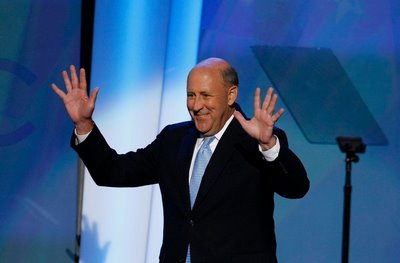
Wisc. Governor JimDoyle (D)
“Clean energy technology and high-end manufacturing are Wisconsin’s future,” Governor Jim Doyle said in his final State of the State address. “We have more than 300 companies and thousands of jobs in the wind industry.”
That statistic is impossible to verify.
The State of Wisconsin does not track those companies nor the jobs within the industry.
When contacted, the Office of Energy Independence (an agency created by Governor Doyle in 2007) directed MacIver News to Wisconsin Wind Works, a self-described “consortium of manufacturers representing the wind manufacturing supply chain within Wisconsin.”
The advocacy group maintains an online wind energy-related supply chain database, although a routine examination of the data proved just how unreliable the figures are.
When the online, searchable database was utilized earlier this summer, it listed 340 companies in Wisconsin connected to the wind industry, a fact which, without additional investigation would appear to be in line with the Governor’s statement.
However, further examination showed many of those companies were not currently serving the wind industry and were only listed because they someday could serve the wind industry.
For example, the database listed 38 manufacturers, but only 24 of them have anything to actually do with the wind energy sector presently.
Of those 24 Wisconsin manufacturers, only eight were categorized as primary suppliers.
Another four companies were listed as both primary and secondary suppliers. A MacIver News Service reporter contacted all eight primary suppliers and the four companies listed as primary/secondary suppliers in our initial query and what we found further eroded the credibility of Governor Doyle’s claims.
When contacted, the companies listed as both primary and secondary suppliers all described themselves merely as secondary suppliers. That means they produce products that are not exclusive to the wind energy.
For example, Bushman Equipment manufactures lifts that move heavy pieces of equipment, which, among many other uses, can be used to handle wind turbines.
Wisconsin Wind Works’ database is not only generous with the number of companies within their supply chain it associates as being primary suppliers, there are issues with the actual job numbers listed for each company as well.
Many of the figures are either inflated, the jobs are not located in Wisconsin, or they cannot be tied to wind energy.
For example, Rexnord Industries was one of the eight Wisconsin manufacturers listed in our query as directly serving the wind energy industry. The database shows the company has 6,000 employees.
Yet a Rexnord official told the MacIver News Service that the company only has 1,500 employees in Wisconsin, and only five of those have jobs which are directly tied to the wind industry.
Wisconsin Wind Works’ database says Orchid International has 600 employees, but a company spokesperson told MacIver it only has 150.
Amsoil Inc. in Superior has 236 employees listed in the Wisconsin Wind Works database, but a company representative told the MacIver News Service that only 6 of them work on wind energy-related products.
In all, at the time of our search, the database claimed 7,632 jobs among the eight manufacturers that were current primary suppliers to the wind industry. Yet, the MacIver News Service was only able to identify 31 jobs at those companies which were specifically tied to wind energy related products.
Manufacturers told MacIver News that other employees might work on wind-related products occasionally, but it does not represent the bulk of their workload.
Another 1,077 workers are listed among the secondary suppliers and we did not investigate that claim.
VAL-FAB, one of the companies listed as both a primary and secondary supplier, explained to MacIver News that it initially had high hopes for the wind energy industry that never materialized. The company specializes in fabrication for the energy sector.
William Capelle, Director of Business Development at VAL-FAB, said “At first we thought we might be able to manufacture the actual towers, but it turns out 90 percent of those are imported from Spain.”
Since the MacIver News Service first examined the Wisconsin Wind Works database, the number of companies listed has increased to 360.
A reporter attempted to contact the organization for comment about the veracity of their data, but Wisconsin wind Works, which solicits members by selling itself as the
“preferred partner of wind energy professionals,” did not respond.
They are, however, holding a Wind Energy Symposium in Milwaukee on October 13th.
Meanwhile the Office of Energy Independence continues to pursue the Doyle Administration’s green energy policies.
As Doyle said during his final State of the State address, “anyone who says there aren’t jobs in the clean energy economy had better open their eyes.”
There is no doubt that some jobs in the wind industry exist in Wisconsin. The accurate number of these ‘green jobs’ is proving to be, at best, elusive
Representatives of Doyle’s office did not respond to repeated request for comments regarding the information contained within this article.
THIRD FEATURE
What to expect when you're expecting wind turbines close to 500 feet tall:
Photos from the Town of Glenmore in Brown County Wisconsin
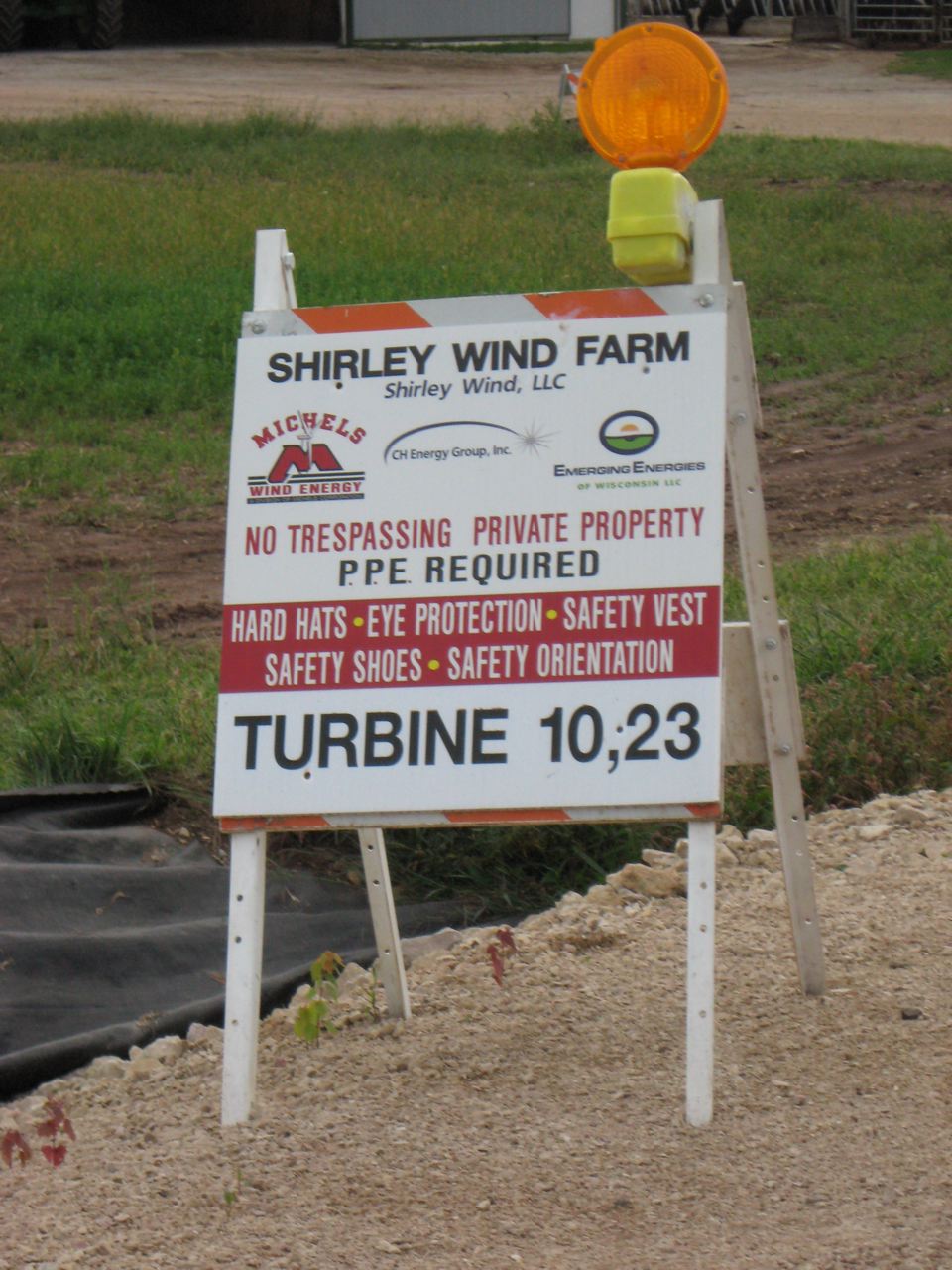

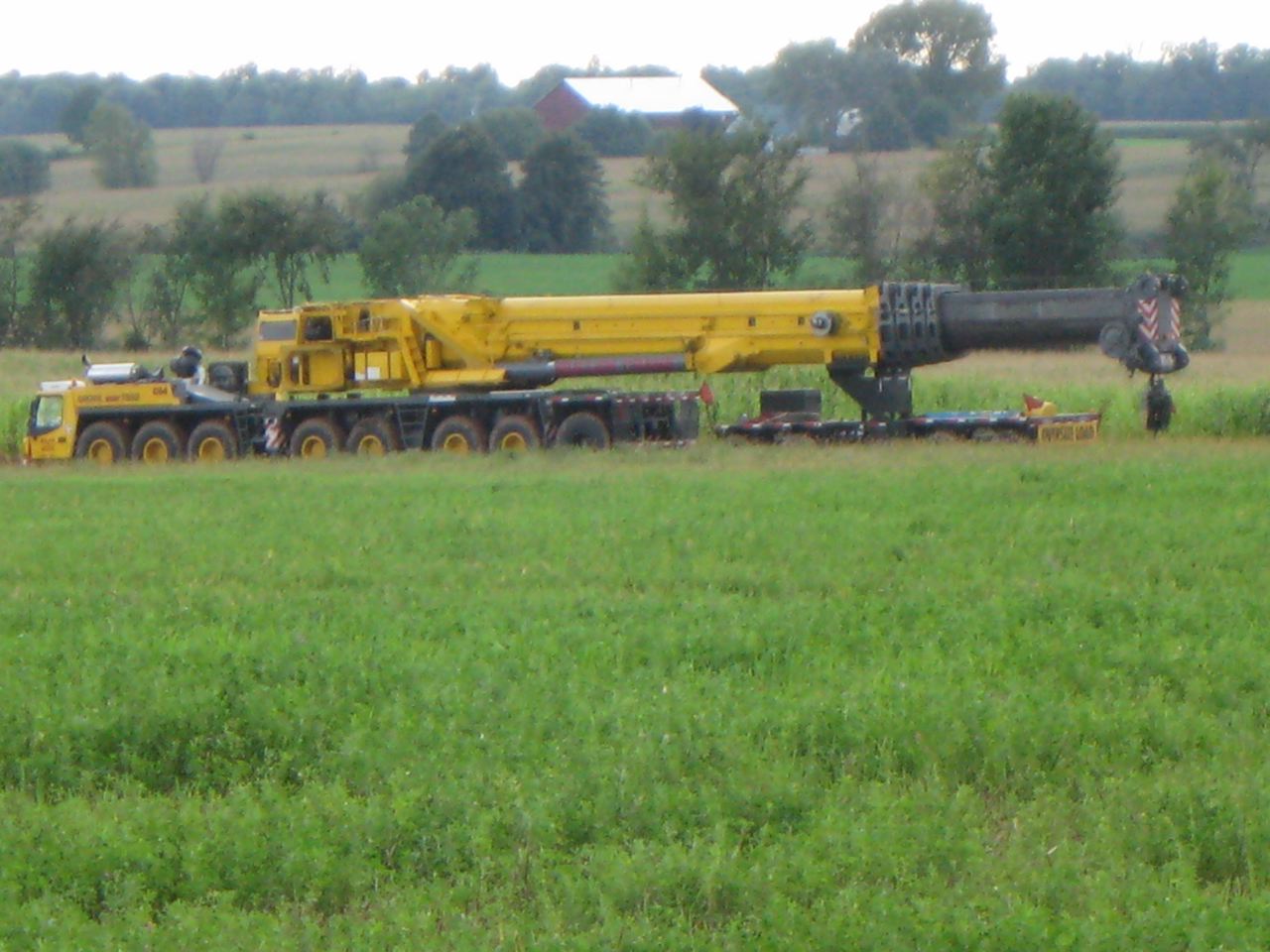
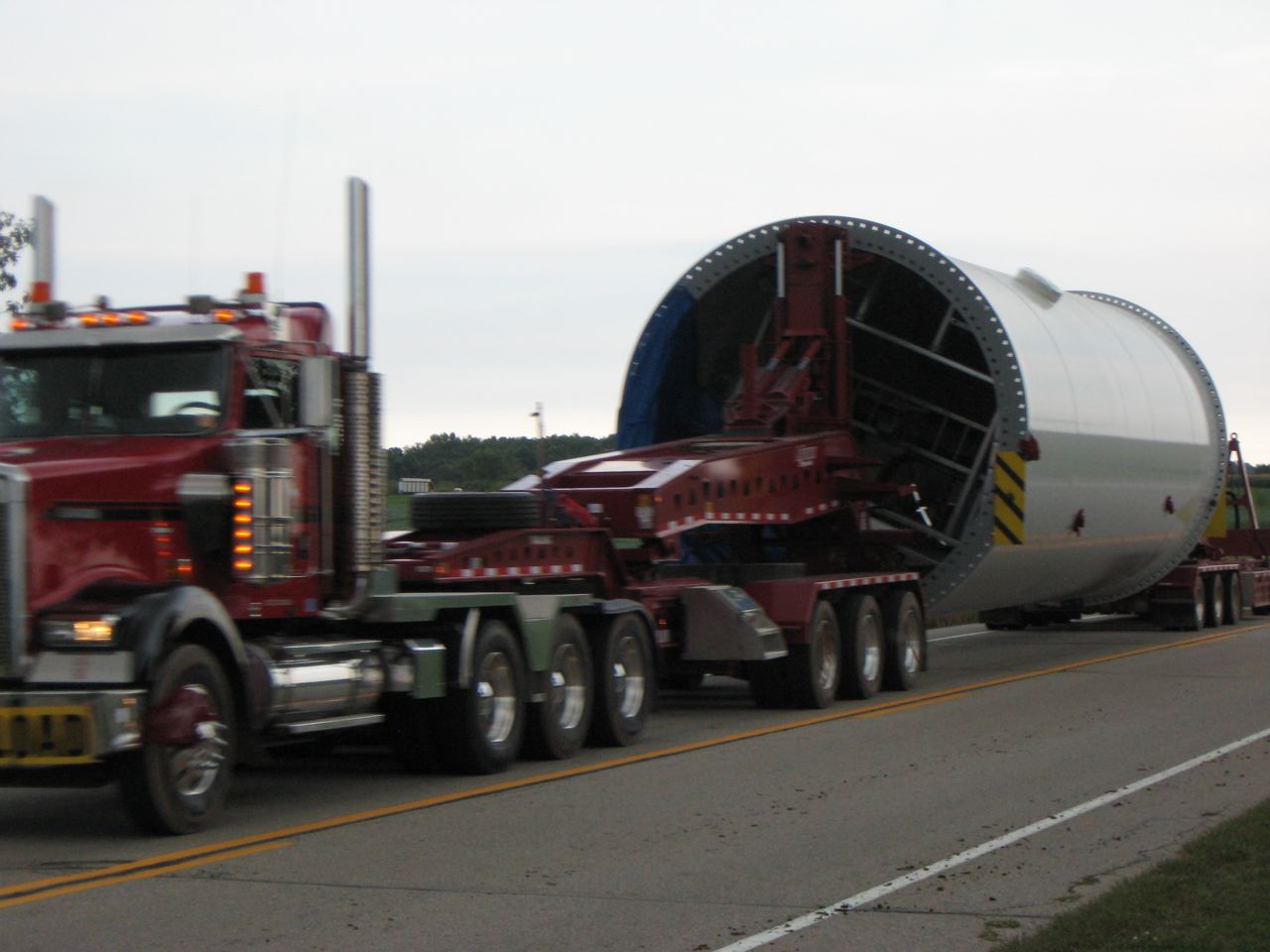
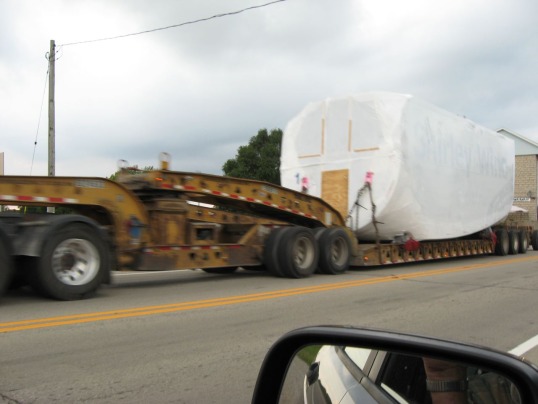

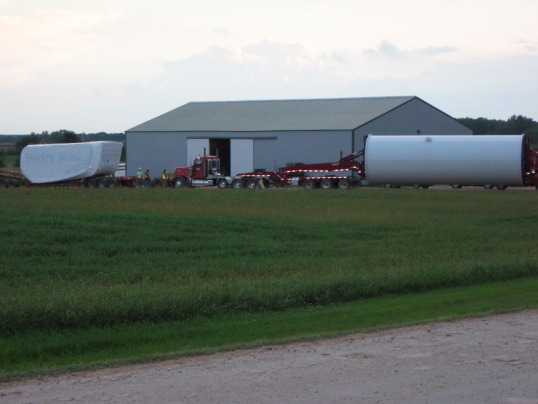
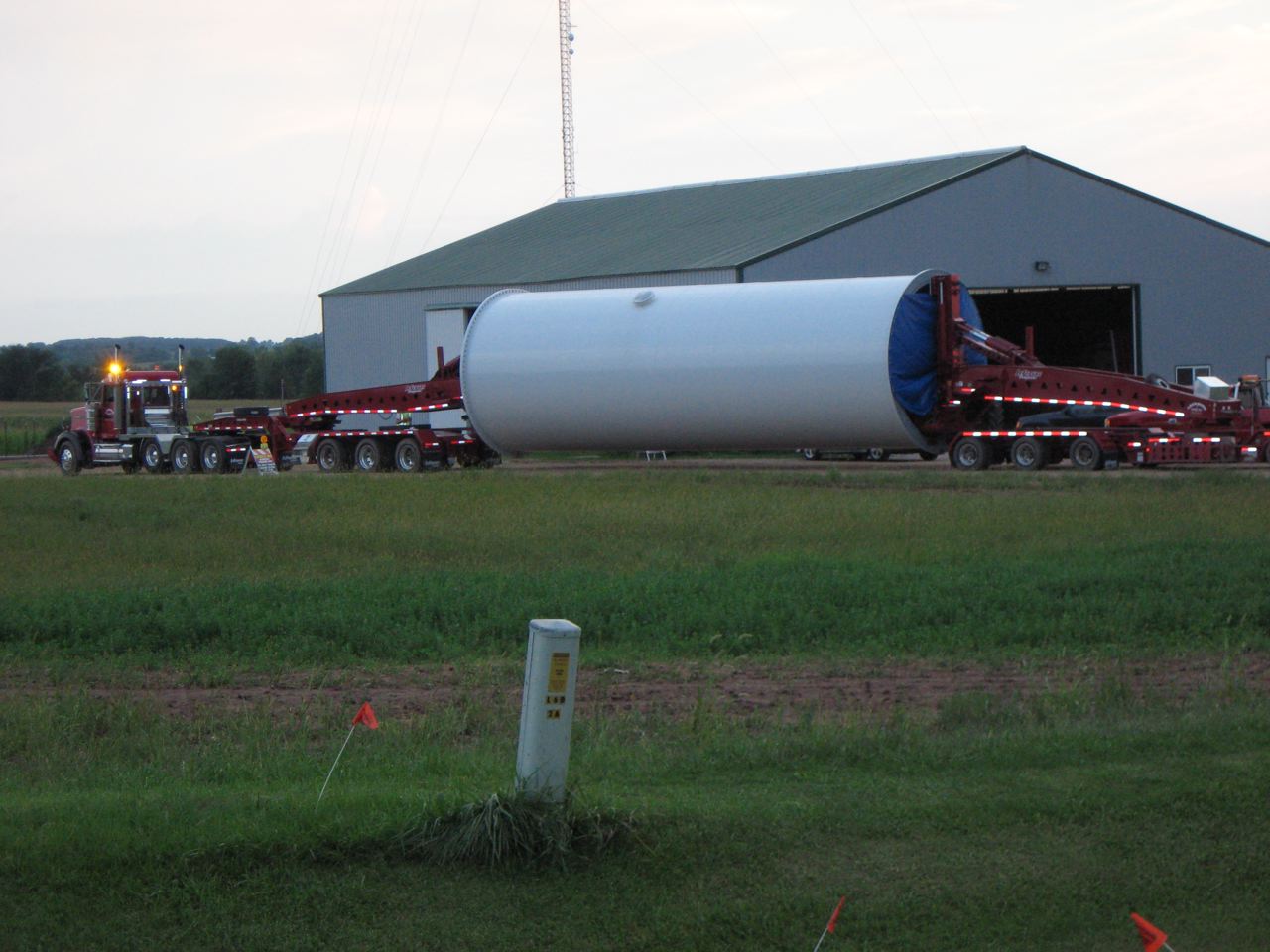
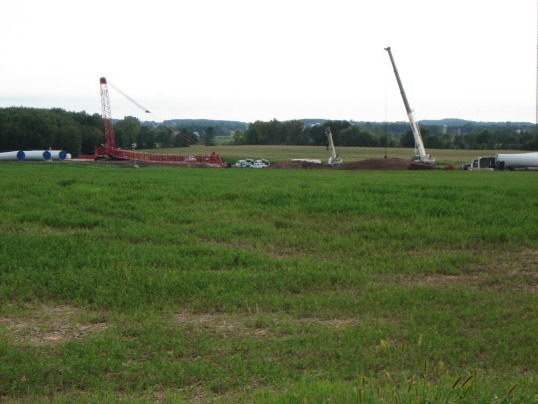
Construction underway on Brown Co. wind farm
8 turbines in Town of Glenmore
TOWN OF GLENMORE - Construction is underway on Brown County's first industrial wind farm. Eight wind turbines are being built in the Town of Glenmore in southern Brown County.
The developer, Wisconsin-based CH Shirley Wind, LLC, says construction is to be completed by the end of the year. The 8 wind turbines are expected to generate enough power to supply approximately 8,000 homes per year.
The wind turbines will stand 492 feet tall.
"We are hoping to generate power by the end of September on at least one turbine. Hopefully all 8 by the end of October," said John Roberts, the construction manager for the project.
The turbines will also provide some extra income for the four families hosting them on their properties.
"They're not just doing it for the money. They like the idea of being green and using their farm for something like this," said Roberts.
Though, like most wind developments, a number of neighbors aren't too happy with the project.
"The projects right now, with the setback rules we have, are just too close for people to live in that proximity to an electrical generator of that size," said Jamie Fletcher, who lives in the Town of Glenmore.
Fletcher has been working to stop all large-scale wind development in southern Brown County. She believes wind turbines cause health problems, mainly from all the noise they make.
"Insomnia, shadow flickers, causing everything from nauseasness to epileptic seizures and I don't want to put my family through that or my animals," said Fletcher.
However, a state committee that studied the issue recently found no health effects from the turbines. Those working on the project in Glenmore also say the turbines being built there have new technology that make them less noisy.
"They're a little bit higher and they turn a little bit slower and because they turn slower, there is actually less noise," said Roberts.
The Shirley Wind project is not part of a highly publicized proposal to build 100 wind turbines in several Brown County communities. That proposal, known as the Ledge Wind Energy Project, has not been voted on yet by the state Public Service Commission. It is being developed by a Chicago-based company called Invenergy.
Opponents, like Jamie Fletcher, say the 8 turbine project in Glenmore will be an example of why other projects should be stopped.
"Whatever happens out here, I pray it's a wake-up call for the rest of the state," she said.
Both sides will continue to debate whether wind development is what is best for Wisconsin.
THIRD FEATURE: A LETTER FROM MAINE:
Note: Like Wisconsin, Maine also passed law that streamlines wind siting for developers by removing local control and relaxing restrictions. Here is what Maine residents are saying two years later:
Though I’d suspected the news would eventually arrive, I still wasn’t ready when I got it.
Word came recently that a wind speed test tower, the harbinger of a future wind turbine development, would soon be erected just north of my property in Lexington Township.
Two more associated towers are to be located in Concord, the next township to the east.
My town is now among the unfortunate that have been infected with the virus of wind-energy sprawl. Industry activity, lately, has been substantial in our area and our town lies within the new expedited permitting zone. It was bound to happen.
I’ve been working to stop wind-sprawl on Maine’s rural landscape for almost a year.
However, until now, I’ve not known the full complement of the frustration, indignation and betrayal felt by so many Mainers seeing their lives turned upside down by the reckless and uncaring intrusion of this industry on their homes and property — all with the complicity of our state government.
I have worked beside many of these people for months, but only now do I fully understand their perspective.
My wife and I believed we’d spend the rest of our days in Lexington, living simply, and feeling fortunate to be surrounded by Maine’s unique beauty and the increasingly rare silence of a rural land.
The governor and Legislature, however, sealed our fate in 2008 when they gifted the wind industry with easy permitting terms for a scheme that is unlikely to produce benefits greater than what will be stolen from present and future generations.
Under the new laws, property owners have been left with little power to protect themselves. I will, nevertheless, continue to fight this industry’s assault on rural Maine, perhaps, with a keener awareness of what we stand to lose.
Alan Michka
Lexington
8/18/10 What does the Final report from the wind siting council say? What are the new wind siting rules for Wisconsin?The noise heard 'round the world: Wind turbines in the news
 THE RULES FOR WISCONSIN ARE HERE:
THE RULES FOR WISCONSIN ARE HERE:
Click here to download the text of the new wind siting rules released today.
The rules are now in the hands of the three PSC commissioners who will decide on the final version of the rules in a few weeks.
WIND TURBINES IN THE NEWS:
Blown in the Wind
Aug. 16, 2010
They like everything big in Texas, and wind energy is no exception. Texas has more wind generation capacity than any other state, about 9,700 megawatts. (That's nearly as much installed wind capacity as India.) Texas residential ratepayers are now paying about $4 more per month on their electric bills in order to fund some 2,300 miles of new transmission lines to carry wind-generated electricity from rural areas to the state's urban centers.
It's time for those customers to ask for a refund. The reason: When it gets hot in Texas—and it's darn hot in the Lone Star State in the summer—the state's ratepayers can't count on that wind energy. On Aug. 4, at about 5 p.m., electricity demand in Texas hit a record: 63,594 megawatts. But according to the state's grid operator, the Electric Reliability Council of Texas, the state's wind turbines provided only about 500 megawatts of power when demand was peaking and the value of electricity was at its highest.
Put another way, only about 5 percent of the state's installed wind capacity was available when Texans needed it most. Texans may brag about the size of their wind sector, but for all of that hot air, the wind business could only provide about 0.8 percent of the state's electricity needs when demand was peaking.
Why does Texas get so little juice from the wind when it really needs it? Well, one of the reasons Texas gets so hot in the summer is that the wind isn't blowing. Pressure gradients—differences in air pressure between two locations in the atmosphere—are largely responsible for the speed of the wind near the Earth's surface. The greater the differences in pressure, the harder the wind blows. During times of extreme heat these pressure gradients often are minimal. The result: wind turbines that don't turn.
Lest you think the generation numbers from Aug. 4 are an aberration, ERCOT has long discounted wind energy's capabilities. In 2007, ERCOT determined that just "8.7 percent of the installed wind capability can be counted on as dependable capacity during the peak demand period for the next year." And in 2009, the grid operator reiterated that it could depend on only 8.7 percent of Texas' wind capacity.
The incurable variability of wind is not restricted to Texas. Consider the problems with wind energy during the frigid weather that hit Britain last winter. In January, the Daily Telegraph reported that the cold weather was accompanied by "a lack of wind, which meant that only 0.2 [percent] of a possible 5 [percent] of the UK's" electricity was generated by wind over the preceding few days.
Understanding wind's unreliability is critically important now, at a time when America's basic infrastructure is crumbling and in desperate need of new investment. In June, the Government Accountability Office issued a report that said that "communities will need hundreds of billions of dollars in coming years to construct and upgrade wastewater infrastructure." Add in the need for new spending on roads, dams, bridges, pipelines, and mass transit systems, and it quickly becomes clear that politicians' infatuation with wind energy is diverting money away from projects that are more deserving and far more important to the general public.
Imagine a company proposed to construct a bridge in Minneapolis, or some other major city, that would cost, say, $250 million. The road would be designed to carry thousands of cars per day. But there's a catch: During rush hour, the thoroughfare would effectively be closed, with only 5 percent, or maybe 10 percent, of its capacity available to motorists. Were this scenario to actually occur, the public outrage would be quick and ferocious.
That's exactly the issue we are facing with wind energy. The reality is that towering wind turbines—for all their allure to certain political groups—are simply supernumeraries in our sprawling electricity delivery system. They do not, cannot, replace coal-fired, gas-fired, or (my personal favorite) nuclear power plants.
Despite these facts, wind-energy lobbyists have been wildly successful at convincing the public and—more importantly—politicians, that wind energy is the way of the future. More than 30 states now have rules that will require dramatic increases in renewable electricity production over the coming years. And wind must provide most of that production, since it's the only renewable source that can rapidly scale up to meet the requirements of the mandate.
The problems posed by the intermittency of wind could quickly be cured if only we had an ultra-cheap method of storing large quantities of energy. If only. The problem of large-scale energy storage has bedeviled inventors for centuries. Even the best modern batteries are too bulky, too expensive, and too finicky. Other solutions for energy storage like compressed-air energy storage and pumped water storage are viable, but like batteries, those technologies are expensive. And even if the cost of energy storage falls dramatically—thereby making wind energy truly viable—who will pay for it?
An unbiased analysis of wind energy's high costs and flaccid contribution to our electricity needs is essential in this time of economic constraint. Despite the dismal economic news, despite the fact that the wind-energy sector, through the $0.022 per-kilowatt-hour production tax credit, gets subsidies of about $6.40 per million Btu of energy produced—an amount that, according to the Energy Information Administration, is about 200 times the subsidy received by the oil and gas sector—wind-energy lobbyists are calling for yet more mandates. On July 27, the American Wind Energy Association issued a press release urging a federal mandate for renewable electricity and lamenting the fact that new wind-energy installations had fallen dramatically during the second quarter compared to 2008 and 2009. The lobby group's CEO, Denise Bode, declared that the "U.S. wind industry is in distress."
Good. Glad to hear it. It's high time we quit blowing so much money on the wind.
REVISIT NOISE STANDARDS
Noise standards paving the way for billion-dollar wind-farm developments across the country are biased and should be ripped up, academics say.
“One can only come to the conclusion that the concept is mainly a business promotion and public relations exercise which has been devised to appear to be taking into consideration the health and welfare of local residents but is designed to get the most out of the investment for the cheapest outlay, without causing the community to take serious legal action against the developer and territorial authority,”
- Philip Dickinson, Massey University acoustics professor who says the wind turbine noise standard, and those elsewhere in the world, appeared to be based on “scientific nonsense”.
SOURCE: The Press News , August 18, 2010 READ COMPLETE STORY BY CLICKING HERE
8/7/10 Do bird and bat deaths matter to Big Wind?
NOTE FROM THE BPWI RESEARCH NERD: Why are more bats being killed in Wisconsin wind projects than anywhere else in the nation? Three recent post construction mortality studies show turbine related kill numbers in our state to be ten times the national average. They are even higher than those mentioned in the article below.
Bird, bat deaths prompt call for St. Lawrence Valley wind moratorium.
SOURCE North Country Public Radio, www.northcountrypublicradio.org
August 6 2010
Save the River, an environmental group based in Clayton, NY, wants a three-year delay in development of more wind power along the St. Lawrence River.
A spokesperson for the group says there are proposals for some 400 wind turbines in the Thousand Island region. Preliminary numbers from a study at an 86-turbine wind farm on Wolfe Island, a Canadian island near Kingston, Ontario, show higher than usual mortality among birds and bats. Martha Foley has more.
An environmental group is calling for a three-year moratorium on building more wind turbines in the St Lawrence Valley. Save The River points to recently released data indicating the 86-turbine wind farm on Wolfe Island caused more than a 1800 bird and bat deaths in six months.
The group’s assistant director Stephanie Weiss says that’s more than double the national average. “When we’re comparing these numbers, we’re talking about how many birds are dying in a 12-month period. The national average might be 2 or 3 or even as high as 4. But the numbers we’re seeing out of Wolfe Island are 8 birds per turbine, in a six-month period,” Weiss said.
Wolfe Island is Canadian territory. In Canada, the province decides where wind farms can be built. In New York State, it’s up to local town governments. Weiss says a moratorium would give them time to find out why avian mortality rates are so high on Wolfe Island. It’s the only wind farm on the St Lawrence River and it’s six months into a three-year study on bird and bat deaths caused by turbines.
“There are a lot of reasons why this could happen. Wolfe Island itself is an important bird area, designated by Nature Canada. It’s a part of the fly way, which is really important. We know there’s some really essential grassland habitat here. We know it’s incredibly important over-wintering raptor area,” said Weiss.
Weiss says once a wind farm is built, environmental damage is hard to undue. She says 400 wind turbines have been proposed in the Thousand Islands. And a thorough study at Wolfe Island will help local officials make the best decisions about if, and where, they should be built. “We can’t just guess at what kind of bird and bat mortality we would have. The three years are essential. I don’t think it’s too long. The wind will still be there,” Weiss said.
7/30/10 Wind Turbine troubles North of the border AND Like a bad neighbor (especially in Rock County, Wisconsin) Acciona is there AND The moon is made of green cheese, economic recovery is made of green jobs
Dr. McMurtry on wind turbine concerns.
Click on the image above to hear why this Canadian doctor is concerned about the current state of wind turbine siting regulation.
NOTE FROM THE BPWI RESEARCH NERD:
Contracts signed by local landowners in Rock County were sold when Acciona bought the rights to develop an industrial scale wind project from fledgling wind developer, EcoEnergy.
EcoEnergy did not disclose how much profit they made from selling local contracts to the Spanish wind industry giant, but local landowners will not see a higher payout as a result, or an option to get out of the contract.
Five continguous Rock County townships have adopted ordinances that require wind developers to site turbines at least 2640 feet from non-participating homes.
In a matter of weeks, the Public Service Commission of Wisconsin will issue wind siting rules that will overturn those ordinances along with those of many other Wisconsin Towns and Counties.
Better Plan Wisconsin [BPWI], has repreatedly asked Acciona about its plans for the wind project in Rock County which at one time included siting 67 industrial scale wind turbines in the Town of Magnolia's 36 square miles.
Acciona has thus far failed to respond.
Landowners who signed contracts with EcoEnergy early on are now angered to find that the offer of a reported $4,000 per turbine per year is far below the going rate being offered to farmers in other communities in our state.
Some have expressed a desire to get out of those contracts and renegotiate something on par with what other wind developers are offering. Others want out because they have witnessed the damage and fragmentation of farm fields left behind by wind development in other parts of our state and want no part of it.
Still others have seen their families and communities torn apart by this issue and no longer feel that it is worth it.
However, landowners in Brown and Columbia Counties are finding out just how hard it is to get out of the contracts they signed at the kitchen table with the once 'friendly' wind developer.
Doing business on a handshake has long been the tradition in rural Wisconsin.
It was something that worked well before out-of-state wind developers began to show up at farmsteads with big promises and iron clad contracts.
Meanwhile, on the other side of the world, like a bad neighbor, Acciona is there too.
The Dean Report
(Posted July 28, 2010)
Within weeks of the towers first being turned on, Noel Dean began suffering adverse health effects. Australian newspapers quoted Dean this way: "I was waking up two days in a row with headaches, I'd have to take Panadol but they'd be gone by dinner time.
When the wind is blowing north I got a thumping headache, like someone belted me over the head with a plank of wood and I didn't know whether to go to the hospital or what to do. You couldn't really work."
Other symptoms he and his wife experienced included general malaise, nausea, sleeplessness and general uneasiness.
By July, the Deans had packed up and left their farm.
Around the same time, an investigation of wind farm noise complaints was underway in New Zealand. Residents living near the towers in New Zealand were filing complaints of sleep disturbance, annoyance, anxiety and nausea. As more people in both Australia and New Zealand became comfortable in talking about their health concerns a picture began to emerge that researchers found unusual. There were compelling similarities between experiences in two totally different countries, totally different environments and totally different turbines.
Audible wind farm sound and consequential sleep disturbance, annoyance and anxiety responses were similar for people in both countries. These effects were also experienced even under situations of near inaudible wind turbine sound.
The concerns of the Deans and others living within 3500 meters of operational wind farms triggered more than twelve months of intensive study by a group of 4 qualified researchers.
The result is The Dean Report, a detailed peer-reviewed analysis of the sound levels near the Dean's properties and the potential adverse effects of wind farm activity on human health.
Dr. Robert Thorne PhD[1], who authored the report, based his findings and conclusions on extensive field work, personal investigations, case studies and the development of sound analysis methodologies. He told Windaction.org that "the Dean Report, in its various forms, has been placed in evidence subject to cross-examination before a Board of Inquiry and formal wind farm hearings for the purposes of peer-review and critique. A hypothesis as to cause and effect for adverse health effects from wind farm activity is presented."
In news reports today, wind farm operator, Acciona Energy, insisted "there is already enough existing credible evidence proving there are no health effects from wind farm noise."
We respectfully disagree. The Dean Report makes clear we are only just beginning to understand problem.
[1] Dr. Thorne is a principal of Noise Measurement Services Pty Ltd in Australia. He holds a PhD in Health Science from Massey University, New Zealand. His professional background is the measurement of low background sound levels and the assessment of noise as it affects people.
Windaction.org wishes to express its thanks to Dr. Thorne and Mr. Dean for sharing the Dean Report with us and permitting us to provide its content to our readers.
SECOND FEATURE:
“It’s easier to make the case” about jobs, Viard said, “than it is to say ‘Is wind energy or offshore oil drilling what we should be doing?’”
“The jobs argument is very popular,” Viard added. “It is very annoying to economists.”
As the Senate rushes toward a vote on oil spill legislation, those seeking changes in the bill are loading their arguments with a potent political word: jobs.
The oil and natural gas industry warns that aggressive regulation of oil drilling could kill industry jobs and those beyond the petroleum sector. Renewable power advocates argue that omitting needed climate policies from the Senate bill threatens existing green jobs and fails to bolster those that could be created.
“People want jobs, and all the more so in a situation like this,” with an ongoing recession, said Alan Viard, an economist who is a resident scholar at the American Enterprise Institute. “It naturally has a political resonance.”
But Viard and other economists warn that the jobs arguments is flawed. Industries tend to look only at a policy’s impact on one sector, ignoring the broader economic impact. And they avoid a tough examination of other factors that should dictate policy decisions, such as whether something is worthwhile and what are all the costs.
“It’s easier to make the case” about jobs, Viard said, “than it is to say ‘Is wind energy or offshore oil drilling what we should be doing?’”
“The jobs argument is very popular,” Viard added. “It is very annoying to economists.”
Jobs arguments long have been made to buttress and condemn many proposed policies and became more impassioned with the recession and high unemployment. The 2009 stimulus bill passed on promises it would create jobs. It included grants, loan guarantees and other incentives meant to drive job creation, particularly in the clean energy arena.
President Obama earlier this month promoted his policies as having helped workers. While the White House has not estimated how many clean-energy jobs its policies have spawned or protected, it said that overall the Recovery Act has saved or created 2.5 million to 3.6 million jobs (Greenwire, July 15).
Democrats, renewable energy sectors and environmental groups promote the potential for “green job” creation as one of the reasons passage of climate legislation is crucial. Climate legislation now appears dead for this session, but as the oil spill bill moves forward, the jobs argument thrives.
Denise Bode, CEO of the American Wind Energy Association, on Tuesday decried Senate Majority Leader Harry Reid’s plan to omit from the bill a renewable electricity standard, a national mandate requiring utilities to use some green power(Greenwire, July 27).
“We are going to see jobs lost,” Bode said. “We are going to see manufacturing facilities not built in the United States. For 85,000 people employed by the wind sector,” she said, “this is about survival as an industry.”
Clean Energy Works, an alliance of about 60 groups that want climate legislation, on Tuesday sent an e-mail to reporters with the subject line “CEOs: Obstruction of Climate Bill Sends Jobs to China, Dollars to Enemies, Increases Pollution at Home.”
The fossil fuel industry also is talking jobs, asserting that over-regulation of the sector could be devastating for workers.
“This would cut domestic production, kill American jobs, slow economic growth and cost billions in federal oil and natural gas revenues,” said Jack Gerard, American Petroleum Institute president and CEO, about a proposal to lift limits on petroleum company liability for oil spill damages (Greenwire, July 27).
“Majority Leader Reid suggests his bill will create 150,000 new jobs,” Gerard added, “but our analysis indicates that failing to develop in the deepwater of the Gulf of Mexico will cost more than that — 175,000 jobs, the majority of them in already hard-hit Gulf Coast communities.”
Any new jobs?
The reality, economists said, is that although a recession can temporarily shrink the number of jobs, there are roughly the same number of people working at any given time. Government policies can shift where those jobs exist, but for the most part not eliminate or create them, they said.
“Arguments about … the job-creating or job-destroying effects of climate legislation, those sort of miss the point,” said Chad Stone, chief economist at the nonprofit Center on Budget and Policy Priorities. “A transformation to a green economy would change the composition of jobs in the economy, not the aggregate number of jobs.”
Wind’s trade group argues that an renewable electricity standard would provide long-term stability for the industry and encourage private investment, leading to job growth. But that fails to acknowledge that policy could hurt jobs elsewhere, like in the coal industry, said Adele Morris, policy director for climate and energy economics at the Brookings Institution.
“The wind people, they want to focus on the gross jobs in their industry, not the net jobs across the economy,” Morris said. There may be other reasons to want wind versus coal jobs, she said, but that is a different argument.
The wind group disagreed.
“There are differences from one technology to another, and renewables tend to be more job-intensive energy sources,” AWEA said. “A critical portion of the jobs we are talking about here are manufacturing jobs, to make the 8,000 components that go into a modern wind turbine, and to create a U.S. supply chain here in the U.S. for wind and other renewable energy manufacturing.
“If those manufacturing jobs aren’t created here, they will go in Europe or China,” AWEA added. “Winning the clean energy manufacturing race is the critical opportunity right now with the RES.”
For environmental goals to succeed, Morris said, the power made from green sources has to be as inexpensive as possible. That means making the technology in the least expensive place possible. She did not say where that might be.
“Any policy that’s designed to drive manufacturing toward more expensive locations is ultimately going to undermine the environmental goal,” Morris said.
When government policies eliminate some jobs, over the long run the labor market adjusts, Morris said.
“The people who are employed in that industry eventually migrate to other sectors,” Morris said.
Larger effect
Over the short term, however, economists acknowledge adjustments can be painful to some workers and regions. The extent of that impact is open to some debate.
The American Petroleum Institute argues that an extended moratorium on deepwater oil drilling, or changes in tax law that make drilling less profitable, will eliminate jobs in the oil industry and well beyond it.
A report released Tuesday by the industry trade group says that more than 175,000 jobs would be affected annually by those kind of policies. It looked at the period from 2013 through 2035.
API reaches that number in its report by combining workers in three groups. It said that 30,183 oil company jobs would be at risk with a long-term moratorium. The analysis then adds in jobs indirectly connected to the industry, like workers with companies that make a product used in oil drilling or who work for a support company, like operators of contracted drilling rigs. That is another 63,207 positions, API said.
But the API report sees the affected employment pool as even bigger than those groups. The API study also includes all of the jobs that are affected by how oil company and ancillary business workers spend their wages. Those workers eat in a nearby restaurant, for example, and the report counts the job of the cook as also being relevant, said Kyle Isakower, API’s vice president of regulatory and economic policy. Those jobs, called the “induced effect,” total 82,051.
“Contrary to popular belief, the benefits of oil and gas development and production are not restricted to a narrow sector of the economy,” the API report says. “Rather, its impacts are broad-based benefiting manufacturing, construction, real estate, finance and insurance, health and social services among others.”
The same could be said of all jobs, some economists said. There is only so much money being spent in society at any one time, Viard said, and how it is spent has effects on different people.
“It’s absolutely true if I spend a dollar on offshore drilling instead of spending it on a hamburger, that is going to have a whole series of ripple effects,” Viard said. But the induced effect of not spending that dollar on the hamburger “is equally wide,” he said.
If an oil company did not spend money on drilling, Viard said, it might choose to return it to shareholders, who might spend it elsewhere or invest it, which could drive down interest rates and benefit home buyers.
“Everything affects everything,” Viard said. “There’s no way to trace where that money would go, but it would go somewhere, and wherever it went it would create jobs, direct, indirect and induced.”
Not all jobs have equal positive impacts on society, Isakower said.
“While there will be an induced effect for any job, some jobs have greater induced effects than others,” Isakower said. Oil industry jobs are among those that benefit many others, he said, because “they do tend to be higher-paying jobs than the national average.”
A moratorium could cause short-term pain to oil industry jobs and support businesses, Morris said, because those jobs tend to be concentrated in a few geographic areas.
“Workers can’t instantly change what industry their skills are suited to,” Morris said, and small businesses that service the oil drilling sector cannot quickly relocate.
“There’s no question that in the short run there can be economic disruption,” Morris said. “That doesn’t mean by itself [that a moratorium] is a bad policy. We could be buying time to prevent further economic degradation down the line.”
Economists argued that policy decisions should not be made solely or even largely on the basis of whether they will hurt or help jobs.
“Otherwise,” Viard said, “we would still have the horse-and-buggy industry because we didn’t want to lose horse-and-buggy jobs.”
